I have recently written about the spread of Pre-Yamnaya or Yamnaya ancestry and Corded Ware-related ancestry throughout Eurasia, using exclusively analyses published by professional geneticists, and filling in the gaps and contradictory data with the most reasonable interpretations. I did so consciously, to avoid any suspicion that I was interspersing my own data or cherry picking results.
Now I’m finished recapitulating the known public data, and the only way forward is the assessment of these populations using the available datasets and free tools.
Understanding the complexities of qpAdm is fairly difficult without a proper genetic and statistical background, which I won’t pretend to have, so its tweaking to get strictly correct results would require an unending game of trial and error. I have sadly little time for this, even taking my tendency to procrastination into account… so I have used a simple model akin to those published before – in particular, the outgroup selection by Ning, Wang et al. (2019), who seem to be part of the only group interested in distinguishing Yamnaya-related from Corded Ware-related ancestry, probably the most relevant question discussed today in population genomics regarding the Proto-Indo-European and Proto-Uralic homelands.
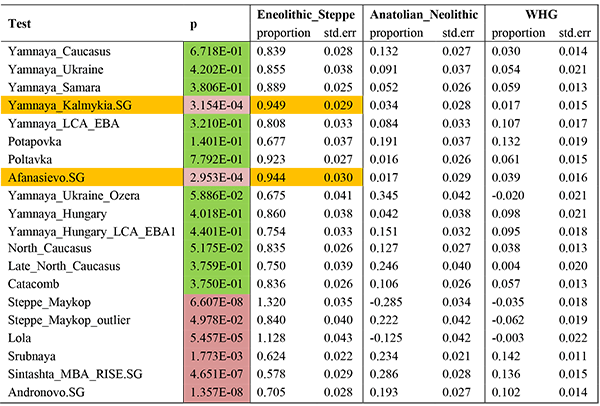
Left populations: Test, Eneolithic_steppe, Anatolian_Neolithic, WHG.
Right populations: Mbuti.DG, Ust_Ishim.DG, Kostenki14, MA1, Han.DG, Papuan.DG, Onge.DG, Villabruna, Vestonice16, ElMiron, Ethiopia_4500BP.SG, Karitiana.DG, Natufian, Iran_Ganj_Dareh_Neolithic.
I have used for all analyses below a merged dataset including the curated one of the Reich Lab, the latest on Central and South Asia by Narasimhan, Patterson et al. (2019), on Iberia by Olalde et al. (2019), and on the East Baltic by Saag et al. (2019), as well as datasets including samples from Wang et al. (2019) and Lamnidis et al. (2018). I used (and intend to use) the same merged dataset in all cases, despite its huge size, to avoid adding one more uncontrolled variable to the analyses, so that all results obtained can be compared.
I try to prepare in advance a bunch of relevant files with left pops and right pops for each model:
- It seems a priori more reasonable to use geographically and chronologically closer proxy populations (say, Trypillia or GAC for Steppe-related peoples) than hypothetic combinations of ancestral ones (viz. Anatolian farmer, WHG, and EHG).
- This also means using subgroups closer to the most likely source population, such as (Don-Volga interfluve) Yamnaya_Kalmykia rather than (Middle Volga) Yamnaya_Samara for the western expansion of late Repin/early Yamnaya, or the early Germany_Corded_Ware.SG or Czech_Corded Ware for the group closest to the Proto-Corded Ware population (see below), likely neighbouring the Upper Vistula region.
- I usually test two source populations for different targets, which seems like a much more efficient way of using computer resources, whenever I know what I want to test, since I need my PC back for its normal use; whenever I don’t know exactly what to test, I use three-way admixture models and look for subsets to try and improve the results.
I have probably left out some more complex models by individualizing the most relevant groups, but for the time being this would have to do. Also, no other formal stats have been used in any case, which is an evident shortcoming, ruling out an interpretation drawn directly and only from the results below.
Full qpAdm results for each batch of samples are presented in a Google Spreadsheet, with each tab (bottom of the page) showing a different combination of sources, usually in order of formally ‘best’ (first to the left) to ‘worst’ (last to the right) fits, although the order is difficult to select in highly heterogeneous target groups, as will be readily visible.
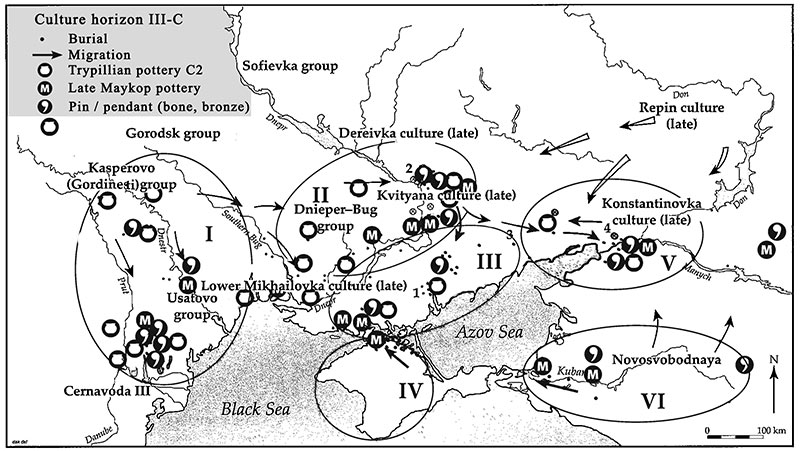
Corded Ware origins
The latest publications on the Yampil barrow complex have not improved much our understanding of the complexity of Corded Ware origins from an archaeological point of view, involving multiple cultural (hence likely population) influences. This bit is from Ivanova et al., Baltic-Pontic Studies (2015) 20:1, and most hypotheses of the paper remain unanswered (except maybe for the relevance of the Złota group):
In the light of the above outline therefore one should argue that the ‘architecture of barrows’ associated in the ‘Yampil landscape’ of the Middle Dniester Area with the Eneolithic (specifically, mainly with the TC), precedes the development of a similar phenomenon that can be observed from 2900/2800 BC in the Upper Dniester Area and drainage basin of the Upper Vistula, associated with the CWC [Goslar et al. 2015; Włodarczak 2006; 2007; 2008; Jarosz, Włodarczak 2007]. The most consuming research question therefore is whether ritual customs making use of Eneolithic (Tripolye) ‘barrow architecture’ could have penetrated northwards along the Dniester route, where GAC communities functioned. One could also ask what role the rituals played among the autochthons [Kośko 2000; Włodarczak 2008; 2014: 335; Ivanova, Toshchev 2015b].
This issue has already been discussed with a resulting tentative systemic taxonomy in the studies of Włodarczak, arguing for the Złota culture (ZC) in the Vistula region as an illustration of one of the (Małopolska) reception centres of civilization inspirations from the oldest Pontic ‘barrow culture’ circle associated with the Eneolithic and Early Bronze Age [Włodarczak 2008]. Notably, it is in the ZC that one can notice a set of cultural traits (catacomb grave construction, burial details, forms and decoration of vessels) analogous to those shared by the north-western Black Sea Coast groups of the forest-steppe Eneolithic (chiefly Zhyvotilovka-Volchansk) and the Late Tripolye circle (chiefly Usatovo-Gordinești-Horodiștea-Kasperovtsy).
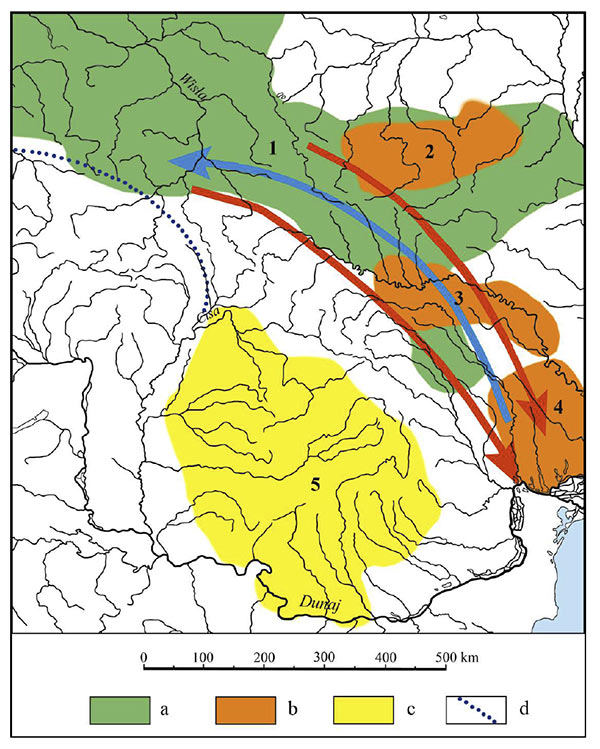
Taking into account that I6561 might be wrongly dated, we cannot include the Corded Ware-like sample of the end-5th millennium BC in the analysis of Corded Ware origins. That uncertainty in the chronology of the appearance of “Steppe ancestry” in Proto-Corded Ware peoples complicates the selection of any potential source population from the CHG cline.
Nevertheless, the lack of hg. R1a-M417 and sizeable Pre-Yamnaya-related ancestry in the sampled Pontic forest-steppe Eneolithic populations (represented exclusively by two samples from Dereivka ca. 3600-3400 BC) would leave open the interesting possibility that a similar ancestry got to the forest-steppe region between modern Poland and Ukraine during the known complex population movements of the Late Eneolithic.
It is known that Corded Ware-derived groups and Steppe Maykop show bad fits for Pre-Yamnaya/Yamnaya ancestry, and also that Steppe Maykop is a potential source of “Steppe-related ancestry” within the Eneolithic CHG mating network of the Pontic-Caspian steppes and forest-steppes. Testing Corded Ware for recent Trypillia and Maykop influences, proper of Late Trypillia and Late Maykop groups in the North Pontic area (such as Zhyvotylivka–Vovchans’k and Gordineşti) side by side with potential Pre-Yamnaya and Yamnaya sources makes thus sense:
Now, the main obvious difference between Khvalynsk-Yamnaya and Corded Ware is the long-lasting, pervasive Y-chromosome bottlenecks under R1b lineages in the former, compared to the haplogroup variability and late bottleneck under R1a-M417 in the latter, which speaks in favour – on top of everything else – of a different community of sub-Neolithic hunter-gatherers including hg. R1a-M417 hijacking the expansion of Steppe_Maykop-related ancestry around the Volhynian-Podolian Upland.
Akin to how Yamnaya patrilineal descendants hijacked regional EEF (±CWC) ancestry components mainly through exogamy, dragging them into the different expanding Bell Beaker groups (see below), but kept their Indo-European languages, these hunter-gatherers that admixed with peoples of “Steppe ancestry” were the most likely vector of expansion of Uralic languages in Eastern Europe.
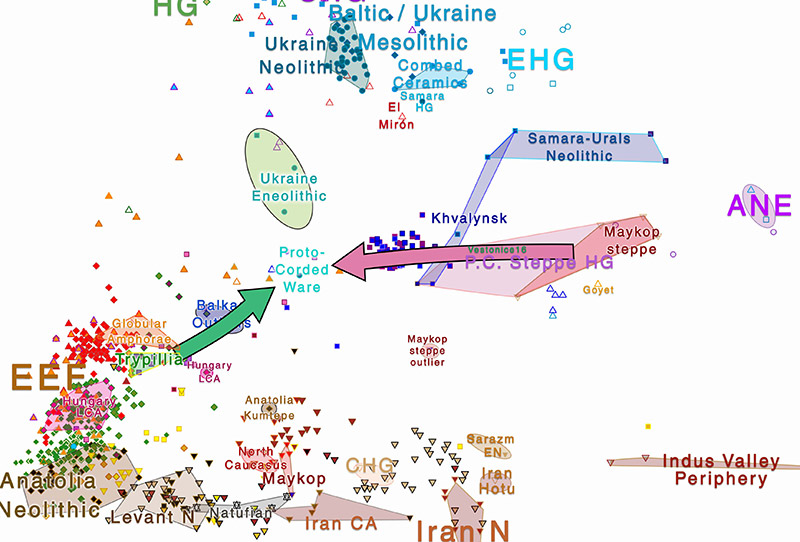
Baltic Corded Ware
One of the most interesting aspects of the results above is the surprising heterogeneity of the different regional groups, which is also reflected in the Y-DNA variability of early Corded Ware samples.
Seeing how Baltic CWC groups, especially the early Latvia_LN sample, show particularly bad fits with the models above, it seems necessary to test how this population might have come to be. My first impression in 2017 was that they could represent early Corded Ware groups admixed with Yamnaya settlers through their interactions along the Dnieper-Dniester corridor.
However, I recently predicted that the most likely admixture leading to their ancestry and PCA cluster would involve a Corded Ware-like group and a group related to sub-Neolithic cultures of eastern Europe, whose best proxy to date are EHG-like Khvalynsk samples (i.e. excluding the outlier with Pre-Yamnaya ancestry, I0434):
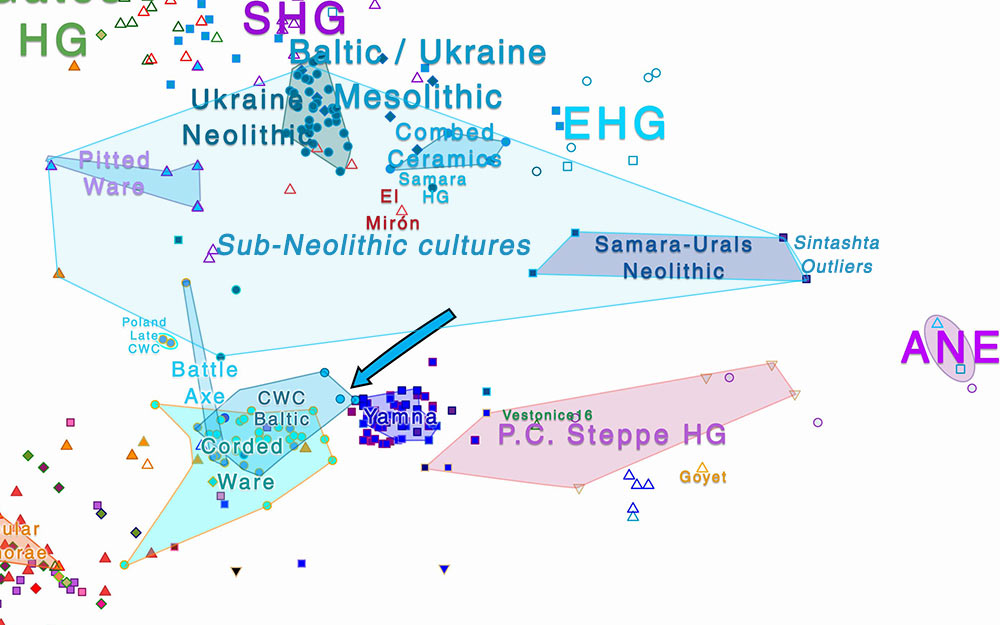
Late Corded Ware + Yamnaya vanguard
Relevant are also the mixtures of Corded Ware from Esperstedt, and particularly those of the sample I0104, which I have repeated many times in this blog I suspected to be influenced by vanguard Yamnaya settlers:
The infeasible models of CWC + Yamnaya_Kalmykia ± Hungary_Baden (see below for Bell Beakers) and the potential cluster formed with other samples from the Baltic suggest that it could represent a more complex set of mixtures with sub-Neolithic populations. On the other hand, its location in Germany, late date (ca. 2500 BC or later), and position in the PCA, together with the good fits obtained for Germany_Beaker as a source, suggest that the increase in Steppe-related ancestry + EEF makes it impossible for the model (as I set it) to directly include Yamnaya_Kalmykia, despite this excess Steppe-related ancestry actually coming from Yamnaya vanguard groups.
I think it is very likely that the future publication of EEF-admixed Yamnaya_Hungary samples (or maybe even Yamnaya vanguard samples) will improve the fits of this model.
These results confirm at least the need to distrust the common interpretation of mixtures including late Corded Ware samples from Esperstedt (giving rise to the “up to 75% Yamnaya ancestry of CWC” in the 2015 papers) as representative of the Corded Ware culture as a whole, and to keep always in mind that an admixture of European BA groups including Corded Ware Esperstedt as a source also includes East BBC-like ancestry, unless proven otherwise.
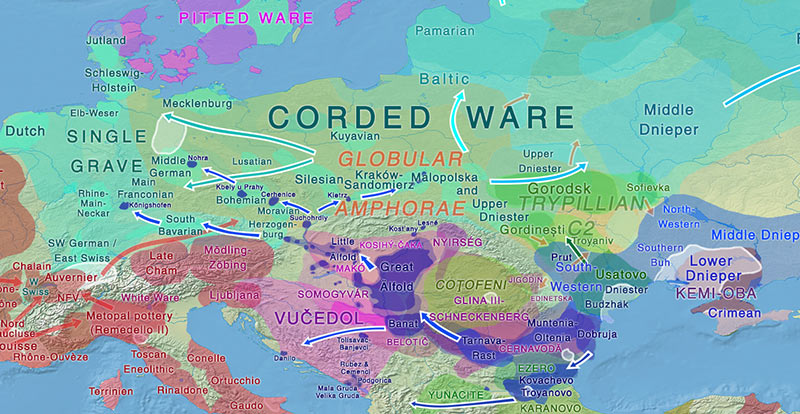
Bell Beaker expansion
A hotly (re)debated topic in the past 6 months or so, and for all the wrong reasons, is the origin of the Bell Beaker folk. Archaeology, linguistics, and different Y-chromosome bottlenecks clearly indicate that Bell Beakers were at the origin of the North-West Indo-European expansion in Europe, while the survival of Corded Ware-related groups in north-eastern Europe is clearly related to the expansion of Uralic languages.
NOTE. For the interesting case of Proto-Indo-Iranians expanding with Corded Ware-like ancestry, see more on the formation of Sintashta-Potapovka-Filatovka from East Uralic-speaking Abashevo and Pre-Proto-Indo-Iranian-speaking Poltavka herders. See also more on R1a in Indo-Iranians and on the social complexity of Sintashta.
Nevertheless, every single discarded theory out there seems to keep coming back to life from time to time, and a new wave of interest in “Bell Beaker from the Single Grave culture” somehow got revived in the process, too, because this obsession – unlike the “Bell Beakers from Iberia Chalcolithic” – is apparently acceptable in certain circles, for some reason.
We know that Iberian Beakers, British Beakers, or Sicilian EBA – representing the most likely closest source population of speakers of Proto-Galaico-Lusitanian, Pre-Celtic Indo-European, and Proto-Elymian, respectively – have already been successfully tested for a direct origin among Western European Beakers in Olalde et al. (2018), Olalde et al. (2019), and Fernandes et al. (2019).
This success in ascertaining a closer Beaker source is probably due to the physical isolation of the specific groups (related to Germany_Beaker, Netherlands_Beaker, and NE_Mediterranean_Beaker samples, respectively) after their migration into regions dominated by peoples without Steppe-related ancestry. Furthermore, Celtic-speaking populations expanding with Urnfield south of the Pyrenees also show a good fit with a source close to France_Beaker.
So I decided to test sampled Bell Beaker populations, to see if it could shed light to the most likely source population of individual Beaker groups and the direction of migration within Central Europe, i.e. roughly eastwards or westwards. As it was to be expected for closely related populations (see the relevant discussion here), an attempt to offer a simplistic analysis of direction based on formal stats does not make any sense, because most of the alternative hypotheses cannot be rejected:
Not only because of the similar values obtained, but because it is absurd to take p-values as a measure of anything, especially when most of these conflicting groups with slightly ‘better’ or ‘worse’ p-values represent multiple different mixtures of the type (Yamnaya + EEF) + (Corded Ware + EEF ± Yamnaya), impossible to distinguish without selecting proper, direct ancestral populations…
A further example of how explosive the Bell Beaker expansion was into different territories, and of their extensive local admixture, is shown by the unsuccessful attempt by Olalde et al. (2018) to obtain an origin of the EEF source for all Beaker groups (excluding Iberian Beakers):

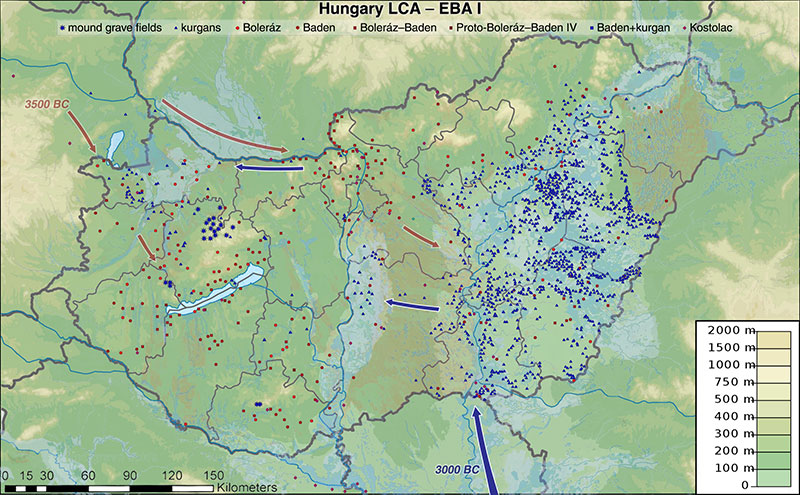
Now, there is a simpler way to understand what kind of Steppe-related ancestry is proper of Bell Beakers. I tested two simple models for some Beaker groups: Yamnaya + Hungary Baden vs. Corded Ware + GAC Poland. After all, the Bell Beaker folk should prefer a source more closely related to either Yamnaya Hungary or Central European Corded Ware:
Interestingly, models including Yamnaya + Baden show good fits for the most important groups related to North-West Indo-Europeans, including Bell Beakers from Germany, the Netherlands, Italy, and Poland, representing the most likely closest source populations of speakers of Pre-Proto-Celtic, Pre-Proto-Germanic, Proto-Italo-Venetic, and Pre-Proto-Balto-Slavic, respectively.
The admixed Yamnaya samples from Hungary that will hopefully be published soon by the Jena Lab will most likely further improve these fits, especially in combination with intermediate Chalcolithic populations of the Middle and Upper Danube and its tributaries, to a point where there will be an absolute chronological and geographical genomic trail from the fully Yamnaya-like Yamnaya settlers from Hungary to all North-West Indo-European-speaking groups of the Early Bronze Age.
The only difference between groups will be the gradual admixture events of their source Beaker group with local populations on their expansion paths, including peoples of mainly EEF, CWC+EEF, or CWC+EEF+Yamnaya related ancestry. There is ample evidence beyond ancestry models to support this, in particular continued Y-DNA bottlenecks under typical Yamnaya paternal lineages, mainly represented by R1b-L51 subclades.

European Early Bronze Age
European EBA groups that might show conflicting results due to multiple admixture events with Corded Ware-related populations are the Únětice culture and the Nordic Late Neolithic.
The results for Únětice groups seem to be in line with what is expected of a Central European EBA population derived from Bell Beakers admixed with surrounding poulations of East Bell Beaker and/or late (Epi-)Corded Ware descent.
Potential models of mixture for Nordic Late Neolithic samples – despite the bad fits due to the lack of direct ancestral CWC and BBC groups from Denmark – seem to be impossible to justify as derived exclusively from Single Grave or (even less) from Battle Axe peoples, supporting immigration waves of Bell Beakers from the south and further admixture events with local groups through maritime domination.
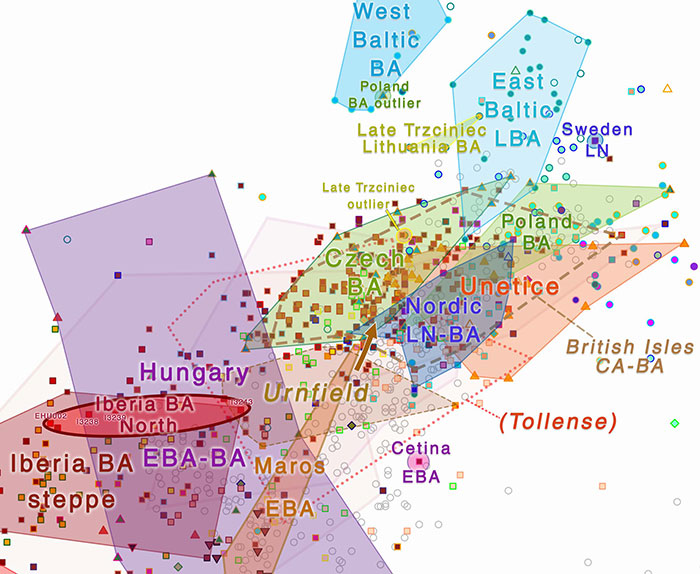
Balkans Bronze Age
The potential origin of the typical Corded Ware Steppe-related ancestry in the social upheaval and population movements of the Dnieper-Dniester forest-steppe corridor during the 4th millennium BC raises the question: how much do Balkan Bronze Age groups owe their ancestry to a population different than the spread of Pre-Yamnaya-like Suvorovo-Novodanilovka chieftains? Furthermore, which Bronze Age groups seem to be more likely derived exclusively from Pre-Yamnaya groups, and which are more likely to be derived from a mixture of Yamnaya and Pre-Yamnaya? Do the formal stats obtained correspond to the expected results for each group?
Since the expansion of hg. I2a-L699 (TMRCA ca. 5500 BC) need not be associated with Yamnaya, some of these values – together with the assessment of each individual archaeological culture – may question their origin in a Yamnaya-related expansion rather than in a Khvalynsk-related one.
NOTE. These are the last ones I was able to test yesterday, and I have not thought these models through, so feel free to propose other source and target groups. In particular, complex movements through the North Pontic area during the Late Eneolithic would suggest that there might have been different Steppe-ancestry-related vs. EEF-related interactions in the north-west and west Pontic area before and during the expansion of Yamnaya.
Mycenaeans
One of the key Indo-European populations that should be derived from Yamnaya to confirm the Steppe hypothesis, together with North-West Indo-Europeans, are Proto-Greeks, who will in turn improve our understanding of the preceding Palaeo-Balkan community. Unfortunately, we only have Mycenaean samples from the Aegean, with slight contributions of Steppe-related ancestry.
Still, analyses with potential source populations for this Steppe ancestry show that the Yamnaya outlier from Bulgaria is a good fit:
The comparison of all results makes it quite evident the why of the good fits from (Srubnaya-related) Bulgaria_MLBA I2163 or of Sintashta_MLBA relative to the only a priori reasonable Yamnaya and Catacomb sources: it is not about some hypothetical shared ancestor in Graeco-Aryan-speaking East Yamnaya– or even Catacomb-Poltavka-related groups, because all available Yamnaya-related peoples are almost indistinguishable from each other (at least with the sampling available today). These results reflect a sizeable contribution of similar EEF-related populations from around the Carpathians in both Steppe-related groups: Corded Ware and Yamnaya settlers from the Balkans.

qpAdm magic
In hobby ancestry magic, as in magic in general, it is not about getting dubious results out of thin air: misdirection is the key. A magician needs to draw the audience attention to ‘remarkable’ ancestry percentages coupled with ‘great’ (?) p-values that purportedly “prove” what the audience expects to see, distracting everyone from the true interesting aspects, like statistical design, the data used (and its shortcomings), other opposing models, a comparison of values, a proper interpretation…you name it.
I reckon – based on the examples above – that the following problems lie at the core of bad uses of qpAdm:
- In the formal aspect, the poor understanding of what p-values and other formal stats obtained actually mean, and – more importantly – what they don’t mean. The simplistic trend to accept results of a few analyses at face value is necessarily wrong, in so far as there is often no proper reasoning of what is being assessed and how, and there is never a previous opinion about what could be expected if the alternative hypotheses were true.
- In the interpretation aspect, the poor judgement of accompanying any results with simplistic, superficial, irrelevant, and often plainly wrong archaeological or linguistic data selected a posteriori; the inclusion of some racial or sociopolitical overtones in the mixture to set a propitious mood in the target audience; and a sort of ritualistic theatrics with the main theme of ‘winning’, that is best completed with ad hominems.
If you get rid of all this, the most reasonable interpretation of the output of a model proposed and tested should be similar to Nick Patterson’s words in his explanation of qpWave and qpAdm use:
Here we see that, at least in this analysis there are reasonable models with CordedWareNeolithic is a mix of either WHG or LBKNeolithic and YamnayaEBA. (…) The point of this note is not to give a serious phylogenetic analysis but the results here certainly support a major Steppe contribution to the Corded Ware population, which is entirely concordant with the archaeology [?].
Very far, as you can see, from the childish “Eureka! I proved the source!”-kind of thinking common among hobbyists.
The Mycenaean case is an illustrative example: if the Yamnaya outlier from Bulgaria were not available, and if one were not careful when designing and assessing those mixture models, the interpretation would range from erroneous (viz. a Graeco-Aryan substrate, as I initially thought) to impossible (say, inventing migration waves of Sintashta or Srubnaya peoples into Crete). The models presented above show that a contribution of Yamnaya to Mycenaeans couldn’t be rejected, and this alone should have been enough to accept Yamnaya as the most likely source population of “Steppe ancestry” in Proto-Greeks, pending intermediate samples from the Balkans. In other words, one could actually find that ‘the best’ p-values for source populations of Mycenaeans is a combination of modern Poles + Turks, despite the impracticality of such a model…
I haven’t been able to reproduce results which supposedly showed that Corded Ware is more likely to be derived from (Pre-)Yamnaya than other source population, or that Corded Ware is better suited as the ancestral population of Bell Beakers. The analyses above show values in line with what has been published in recent scientific papers, and what should be expected based on linguistics and archaeology. So I’ll go out on a limb here and say that it’s only through a careful selection of outgroups and samples tested, and of as few compared models as possible, that you could eventually get this kind of results and interpretation, if at all.
Whether that kind of special care for outgroups and samples is about (a) an acceptable fine-tuning of the analyses, (b) a simplistic selection dragged from the first papers published and applied indiscriminately to all models, or (c) cherry picking analyses until results fit the expected outcome, is a question that will become mostly irrelevant when future publications continue to support an origin of the expansion of ancient Indo-European languages in Khvalynsk- and Yamnaya-related migrations.
Feel free to suggest (reasonable) modifications to correct some of these models in the comments. Also, be sure to check out other values such as proportions, SD or SNPs of the different results that I might have not taken into account when assessing ‘good’ or ‘bad’ fits.
Related
- On the Ukraine Eneolithic outlier I6561 from Alexandria
- Yamnaya replaced Europeans, but admixed heavily as they spread to Asia
- Corded Ware culture origins: The Final Frontier
- Volga Basin R1b-rich Proto-Indo-Europeans of (Pre-)Yamnaya ancestry
- A very “Yamnaya-like” East Bell Beaker from France, probably R1b-L151
- Yamnaya ancestry: mapping the Proto-Indo-European expansions
- Sea Peoples behind Philistines were Aegeans, including R1b-M269 lineages
- Sredni Stog, Proto-Corded Ware, and their “steppe admixture”
- Aquitanians and Iberians of haplogroup R1b are exactly like Indo-Iranians and Balto-Slavs of haplogroup R1a
- Consequences of Damgaard et al. 2018 (II): The late Khvalynsk migration waves with R1b-L23 lineages
- The origin of social complexity in the development of the Sintashta culture
- The genetic and cultural barrier of the Pontic-Caspian steppe – forest-steppe ecotone
- Steppe and Caucasus Eneolithic: the new keystones of the EHG-CHG-ANE ancestry in steppe groups
- On the origin of haplogroup R1b-L51 in late Repin / early Yamna settlers
- On the origin and spread of haplogroup R1a-Z645 from eastern Europe
- Kurgan origins and expansion with Khvalynsk-Novodanilovka chieftains
- About Scepters, Horses, and War: on Khvalynsk migrants in the Caucasus and the Danube
- North Pontic steppe Eneolithic cultures, and an alternative Indo-Slavonic model